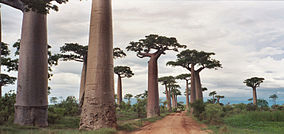No video yet

Avenue of the Baobabs
The Avenue of the Baobabs, or Alley of the Baobabs, is a prominent group of Grandidier's baobabs (Adansonia grandidieri) lining the dirt road between Morondava and Belon'i Tsiribihina in the Menabe region of western Madagascar. Its striking landscape draws travelers from around the world, making it one of the most visited locations in the region. It has been a center of local conservation efforts, and was granted temporary protected status in July 2007 by the Ministry of Environment, Water and Forests—a step towards making it Madagascar's first natural monument.
Description
Along a 260 m (850 ft) stretch of the road is a grove of 20–25 Adansonia grandidieri baobabs. An additional 25 or so trees of this species are found growing over nearby rice paddies and meadows within 9.9 acres (4 ha) of land. The trees, which are endemic to Madagascar, are about 30 m (98 ft) in height.
The baobab trees, known locally as renala (Malagasy for "monkey of the forest"), are up to 2,800 years old. They are a legacy of the dense tropical forests that once thrived on Madagascar. The trees did not originally tower in isolation over the sere landscape of scrub, but stood in dense forest. Over the years, as the country's population grew, the forests were cleared for agriculture, leaving only the baobab trees, which the locals preserved as much for their own sake as for their value as a food source and building material.
Baobab Amoureux
Some 7 km (4.3 mi) to the northwest are the Baobab Amoureux, which are two notable...




